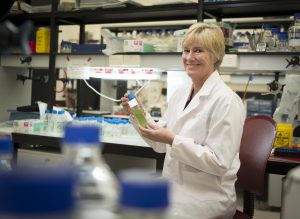
Griffith researchers are helping shed new light on how blue-green algae, or cyanobacteria blooms can continue long after their food source in the water has disappeared.
Published in Proceedings B, the Royal Society’s flagship biological research journal, and conducted at Griffith University’s Australian Rivers Institute, this study investigated the role of cellular nutrient storage in cyanobacteria and their ability to switch nutrient strategies, which leads to ‘winners and losers’ where species of cyanobacteria are competing for limited nutrients.

“Cyanobacteria, commonly known as blue-green algae, are a group of photosynthetic bacteria often associated with water quality problems in freshwater and marine systems,” said co-author , Director of the .
“Several species of cyanobacteria produce toxins that are harmful to aquatic organisms and humans which can become concentrated in waterways and lakes in the event of blue-green algal blooms.”
Blooms of cyanobacteria often happen in response to warm, calm conditions that allow for both the build-up and rapid growth of algal cells.
“However, these cyanobacteria blooms, including toxic species, need nutrients as well,” said co-author of the Australian Rivers Institute.
“Despite ongoing research on cyanobacteria and the use of nutrients as a food source, and how this leads to algal blooms, our understanding of the nutrient-cyanobacteria relationship remains relatively simplistic.”
Most research to date has focused on the amount of nutrients the cyanobacteria have available in the external environment. This has led to confusing results and questionable advice about how to limit and manage nutrient loads going into waterbodies to reduce the potential for cyanobacteria blooms.

However, as researcher, Associate Professor Man Xiao found in her research at Griffith University, blue-green algae have clever ways to hoard nutrients that allow blooms to persist and grow even if the nutrients seem to be absent from the environment. The research points to the need for sustained nutrient reduction strategies to be able to reduce the occurrences of cyanobacteria blooms.
“Information on the tricks that blue-green algae use to dominate and bloom under low-nutrient conditions is critical for predicting biomass as well as species composition,” Professor Hamilton said.
“In our study, we looked at two species of cyanobacteria with different levels of nitrogen and phosphorus in the water to look at how they hoard and use nutrients.”
Some species took up the nutrients as quickly as possible and grew quickly, while others stored nutrients while growing slowly. This allowed them to grow for longer.
“These growth responses are a bet-hedging strategy for the cyanobacteria; either grow quickly and outcompete your competitors or store the nutrients, grow slowly, and gradually replace other species who have run out of nutrients,” Associate Professor Man Xiao said.
This research explains why blue-green algae can continue to grow for long periods of time before they collapse, even when it seems that nutrients aren’t available.
Professor Hamilton concluded that “going forward, we recommend that we rethink our links between cyanobacteria and nutrients because measuring nutrients on their own does not give us an accurate picture. We need clever new ways to approach this”.







